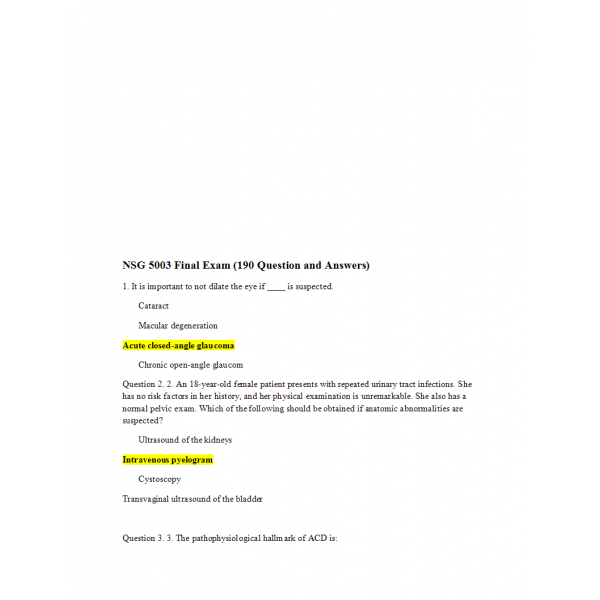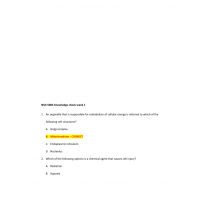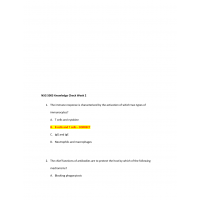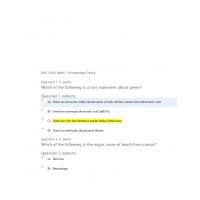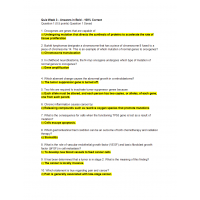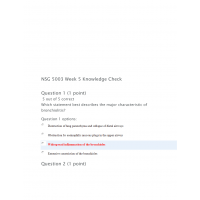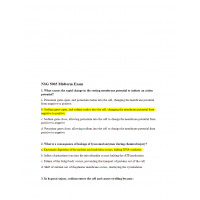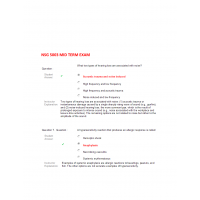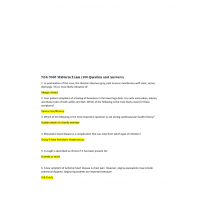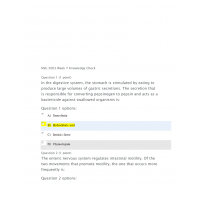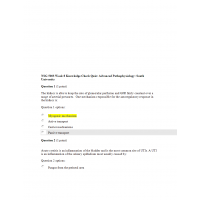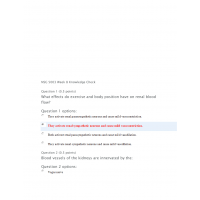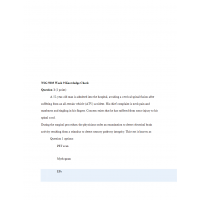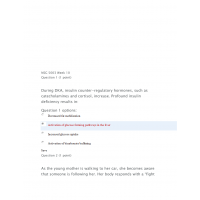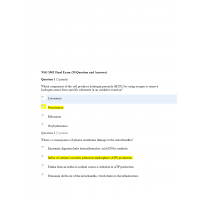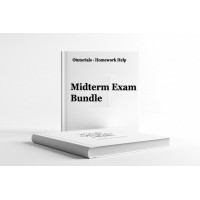NSG 5003 Week 11 Final Exam 2
NSG 5003 Final Exam
1. It is important to not dilate the eye if ____ is suspected.
2. An 18-year-old female patient presents with repeated urinary tract infections. She has no risk factors in her history, and her physical examination is unremarkable. She also has a normal pelvic exam. Which of the following should be obtained if anatomic abnormalities are suspected?
3. The pathophysiological hallmark of ACD is:
4. Which of the following is the most important question to ask during cardiovascular health history?
5. A 26-year-old, non-smoker, male presented to your clinic with SOB with exertion. This could be due to:
6. Which of the following dermatological conditionsresults from reactivation of the dormant varicella virus?
7. Mr. Jones is a 68-year-old retired Air Force pilot that has been diagnosed with prostate cancer in the past week. He has never had a surgical procedure in his life and seeks clarification on the availability of treatments for prostate cancer. He asks the nurse practitioner to tell him the side effects of a radical prostatectomy. Which of the following is not a potential side effect of this procedure?
8. Presbycusis is the hearing impairment that is associated with:
9. Asymptomatic 1+ bacteriuria is found in a nursing home resident with an indwelling catheter. The nurse practitioner’s initial intervention includes:
10. A 64-year-old male presents with erythema of the sclera, tearing, and bilateral pruritus of the eyes. The symptoms occur intermittently throughout the year and he has associated clear nasal discharge. Which of the following is most likely because of the inflammation?
11. The nurse practitioner is examining a 62-year-old female who has been complaining of lower abdominal pain. Upon auscultation, bowel sounds are high pitched and tinkling. Which of the following terms describes this finding?
12. Which ethnic group has the highest incidence of prostate cancer?
13. A key symptom of ischemic heart disease is chest pain. However, angina equivalents may include exertional dyspnea. Angina equivalents are important because:
14. The nurse practitioner is discussing lifestyle changes with a patient diagnosed with gastroesophageal reflux. What are the nonpharmacological management interventions that should be included?
15. Which lesions are typically located along the distribution of dermatome?
16. Which of the following medications are commonly associated with the side effect of cough?
17. On DRE, you note that a 45-year-old patient has a firm, smooth, non-tender but asymmetrically shaped prostate. The patient has no symptoms and has a normal urinalysis. The patient’s PSA is within normal limits for the patient’s age. The clinician should:
18. Your patient complains of a feeling of heaviness in the lower legs daily. You note varicosities, edema, and dusky color of both ankles and feet. Which of the following is the most likely cause for these symptoms?
19. The most common cause of eye redness is:
20. The aging process causes what normal physiological changes in the heart?
21. Ms. Smith, 37-year-old, comes to the clinic today complaining of dull, throbbing bilateral headaches almost every evening. You suspect she is experiencing:
22. A 59-year-old patient with history of alcohol abuse comes to your office because of ‘throwing up blood”. On physical examination, you note ascites and caput medusa. A likely cause for the hematemesis is:
23. Which of the following is considered a “red flag” when diagnosing a patient with pneumonia?
24. Your patient complains of lower abdominal pain, anorexia, extreme fatigue, unintentional weight loss of 10 pounds in last 3 weeks, and you find a positive hemoccult on digital rectal examination. Laboratory tests show iron deficiency anemia. The clinician needs to consider:
25. You have a patient complaining of vertigo and want to know what could be the cause. Knowing there are many causes for vertigo, you question the length of time the sensation lasts. She tells you several hours to days and is accompanied by tinnitus and hearing loss. You suspect which of the following conditions?
26. In examining the mouth of an older adult with a history of smoking, the nurse practitioner finds a suspicious oral lesion. The patient has been referred for a biopsy to be sent for pathology. Which is the most common oral precancerous lesion?
27. A cough is described as chronic if it has been present for:
28. The first assessment to complete related to the eyes is:
29. The Mini-Cog is a short screening tool used to assess cognition. Which of the following statements pertaining to the test is a true statement?
30. A woman with an X-linked dominant disorder will:
31. Your patient has just returned from a 6-month missionary trip to Southeast Asia. He reports unremitting cough, hemoptysis, and an unintentional weight loss of 10 pounds over the last month. These symptoms should prompt the clinician to suspect:
32. In assessing the eyes, which of the following is considered a “red flag” finding when associated with eye redness?
33. The best evidence rating drugs to consider in a post myocardial infarction patient include:
34. In examination of the nose, the clinician observes gray, pale mucous membranes with clear, serous discharge. This is most likely indicative of:
35. Which of the following findings should trigger an urgent referral to a cardiologist or neurologist?
36. Which symptom is more characteristic of Non-Cardiac chest pain?
37. Aortic regurgitation requires medical treatment for early signs of CHF with:
38. What test is used to confirm the diagnosis of appendicitis?
39. The major impact of the physiological changes that occur with aging is:
40. A smooth round nodule with a pearly gray border and central induration best describes which skin lesion?
41. A 20-year-old engineering student complains of episodes of abdominal discomfort, bloating, and episodes of diarrhea. The symptoms usually occur after eating, and pain is frequently relieved with bowel movement. She is on a “celiac diet” and the episodic symptoms persist. Physical examination and diagnostic tests are negative. Colonoscopy is negative for any abnormalities. This is a history and physical consistent with:
42. Which of the following disorders can cause urinary incontinence?
43. Which of the following drugs would be useful for the nurse practitioner to prescribe for an older adult to prevent gastric ulcers when a nonsteroidal anti-inflammatory drug is used for chronic pain management?
44. Which of the following details are NOT considered while staging asthma?
45. A 66-year-old patient presents to the clinic complaining of dyspnea and wheezing. The patient reports a smoking history of 2 packs of cigarettes per day since age 16. This would be recorded in the chart as:
46. A clinical clue for suspected renal artery stenosis would be:
47. What is the most common valvular heart disease in the older adult?
48. The cytochrome p system involves enzymes that are generally:
49. Which of the following is the most common cause of heartburn-type epigastric pain?
50. A nurse practitioner reports that your patient’s abdominal X-ray demonstrates multiple air-fluid levels in the bowel. This is a diagnostic finding found in:
51. A patient suffered a laceration of the shin three days ago, and today presents with a painful, warm, red swollen region around the area. The laceration has a purulent exudate. The clinician should recognize that the infected region is called:
52. A 62-year-old client presents with a complaint of fever, pain, and burning on urination. Difficulty urinating with dribbling has been increasing in the past few days. He has a feeling of pressure in his groin. On examination, his prostate is tender, boggy, and warm. A stat urinalysis reveals the presence of leukocytes and bacteria. He is allergic to sulfa drugs. His weight is 70 kg and his last serum creatinine was 1.0. While awaiting the culture and sensitivity, the nurse practitioner begins empiric treatment with which of the following?
53. In teaching an older adult female client with end-stage renal disease her medication regimen, the nurse practitioner must include which of the following pieces of information in the treatment plan?
54. A 46-year-old female complains of fatigue, general malaise, and pain and swelling in her hands that has gradually worsened over the last few weeks. She reports that pain, stiffness, and swelling of her hands are most severe in the morning. On physical examination, you note swelling of the metacarpophalangeal joints bilaterally. These are common signs of:
55. Whenever a patient presents with acute non-traumatic shoulder pain, the clinician should make sure to exclude a:
56. A female patient presents to the clinic with complaints of a severe, throbbing, unilateral headache. She complains of seeing flashes of light prior to the headache. She complains of sound and light sensitivity as well as nausea. The clinician should recognize these as symptoms of:
57. The main focus of treatment of patients with ACD is:
58. The most common neurological cause of seizures in an older adult is:
59. Your 63-year-old Caucasian woman with polymyalgia rheumatica (PMR) will begin treatment with corticosteroids until the condition has resolved. You look over her records and it has been 2 years since her last physical examination and any laboratory or diagnostic tests as she relocated and had not yet identified a health-care provider. In prioritizing your management plan, your first orders should include:
60. Your patient is a 78-year-old female with a smoking history of 120-pack years. She complains of hoarseness that has developed over the last few months. It is important to exclude the possibility of:
61. A 43-year-old female was in a bicycling accident and complains of severe pain of the right foot. The patient limps into the emergency room. On physical examination, there is no point tenderness over the medial or lateral ankle malleolus. There is no foot tenderness except at the base of the fifth metatarsal bone. According to the Ottawa foot rules, should an X-ray of the feet be ordered?
62. When assessing a patient who complains of a tremor, the nurse practitioner must differentiate essential tremor from the tremor of Parkinson’s disease. Which of the following findings are consistent with essential tremor?
63. Folliculitis is most commonly due to:
64. What kind of lesions are caused by the herpes simplex virus?
65. A 65-year-old male complains of a headache that feels “like a knife is cutting into his head.” He also reports feeling right-sided scalp and facial pain and “seeing double” at times. He has a history of hypertension and hyperlipidemia. His medications include beta blocker, statin drug, and an ACE inhibitor. On physical examination, you note palpable tenderness over the right side of the forehead. There are no neurological deficits. Vision is 20/20 with lenses. No weakness of extremities. CN II to XII are intact. The history corresponds to which of the following disorders?
66. Which of the following conditions is the most common cause of nausea, vomiting, and diarrhea?
67. The nurse practitioner orders bilateral wrist X-rays on a 69-year-old gentleman complaining of pain in both wrists for the past 6 weeks not related to any known trauma. The nurse practitioner suspects elderly onset rheumatoid arthritis. The initial radiographic finding in a patient with elderly onset rheumatoid arthritis would be:
68. A common auscultatory finding in advanced CHF is:
69. The three cardinal features of Parkinson’s disease are:
70. In AR disorders, carriers have:
71. A 75-year-old patient complains of pain and paresthesias in the right foot that worsens with exercise and is relieved by rest. On physical examination you note pallor of the right foot, capillary refill of 4 seconds in the right foot, +1 dorsalis pedis pulse in the right foot, and +2 pulse in left foot. Which of the following is a likely cause of the signs and symptoms?
72. Which of the following statements is true concerning anti-arrhythmic drugs?
73. A 23-year-old patient who has had bronchiectasis since childhood is likely to have which of the following:
74. Which of the following is a common trigger of migraine headache?
75. A 55-year-old patient complains of lower back pain due to heavy lifting at work yesterday. He reports weakness of the left leg and paresthesias in the left foot. On physical examination, the patient has diminished ability to dorsiflex the left ankle. Which of the following symptoms should prompt the clinician to make immediate referral to a neurosurgeon?
76. The appearance of a 2-10 cm. herald patch with subsequent development of parallel oval lesions on the trunk in a christmas tree distribution involving the upper arms and upper legs are common in:
77. When interpreting laboratory data, you would expect to see the following in a patient with Anemia of Chronic Disease (ACD):
78. In differentiating a gastric ulcer from a duodenal ulcer, you know that each type of ulcer can present with distinct signs and symptoms. Which of the following pieces of information from the patient’s history is the least useful for you to determine that the patient has a duodenal ulcer?
79. A 43-year-old male patient complains of right-sided abdominal and pain in the back in the right costovertebral angle region, fever, chills, dysuria, and nausea. On physical examination, there is 102 degree fever, tachycardia, and right costovertebral angle tenderness to percussion. The most likely condition is:
80. A careful history of a female client with a chief complaint of intermittent diarrhea reveals that she also experiences bouts of constipation. She has no known allergies and experienced no unintentional weight loss. What is the most likely condition?
81. A 33-year-old female reports general malaise, fatigue, stiffness, and pain in multiple joints of the body. There is no history of systemic disease and no history of trauma. On physical examination, the patient has no swelling or decreased range of motion in any of the joints. She indicates specific points on the neck and shoulders that are particularly affected. She complains of tenderness upon palpation of the neck, both shoulders, hips, and medial regions of the knees. The clinician should include the following disorder in the list of potential diagnoses:
82. A 60-year-old female patient complains of pain in both hands that is worse in the morning. On physical examination, the thumb metacarpophalangeal joint is swollen on both hands. There is swelling of the proximal and distal interphalangeal joints bilaterally. These are typical signs of:
83. A 68-year-old male reports painless rectal bleeding occasionally noted with thin pencil-like stools, but no pain with defection. He has a history of colon polyp removal 10 years ago but was lost to follow-up. The nurse practitioner’s appropriate intervention is:
84. During physical examination of a patient, you note resonance on percussion in the upper lung fields. This is consistent with:
85. Your 70-year-old patient has gastroesophageal reflux disease (GERD). After a trial of lifestyle modifications and antacids, the patient continues to have occasional mild heartburn after occasional meals and at night. The most appropriate next action is:
86. In order to provide a comprehensive genetic history of a patient, the NP should:
87. An 86-year-old patient who wears a hearing aid complains of poor hearing in the affected ear. In addition to possible hearing aid malfunction, this condition is often due to:
88. A 62-year-old woman presents with a recurrent urinary tract infection. She now has a fever of 104°F and severe costovertebral tenderness with pyuria. What is the appropriate diagnosis and intervention for this patient?
89. When counseling clients regarding the use of antidiarrheal drugs such as Imodium anti-diarrheal and Kaopectate, the nurse practitioner advises patients to:
90. What is the most common cause of hip pain in older adults?
91. A 65-year-old woman is accompanied by her daughter for a physical examination. She has mild heart failure and takes digitalis and an ACE inhibitor. As you examine the patient, you note flat affect, hand tremor, and slowed movements. The tremor is worsened at rest. There are no neurologic deficits. Hand grip, sensation of face and extremities, and lower extremity muscle strength are within normal limits and bilaterally equal. DTRs are equal bilaterally. CN II to XII are intact. The mental status exam is normal. These are key signs of:
92. An older patient reports burning pain after ingestion of many foods and large meals. What assessment would assist the nurse practitioner in making a diagnosis of GERD?
93. An 82-year-old female presents to the emergency department with epigastric pain and weakness. She admits to having dark, tarry stools for the last few days. She reports a long history of pain due to osteoarthritis. She self-medicates daily with ibuprofen, naprosyn, and aspirin for joint pain. On physical examination, she has orthostatic hypotension and pallor. Fecal occult blood test is positive. A likely etiology of the patient’s problem is:
94. Your 2-year-old patient shows facial features, such as epicanthal folds, up-slanted palpebral fissures, single transverse palmar crease, and a low nasal bridge. These are referred to as:
95. The first step in the genomic assessment of a patient is obtaining information regarding:
96. Your patient is a 43-year-old female golfer who complains of arm pain. On physical examination, there is point tenderness on the elbow and pain when the patient is asked to flex the wrist against the clinician’s resistance. These are typical signs of:
97. Upon assessment of respiratory excursion, the clinician notes asymmetric expansion of the chest. One side expands greater than the other. This could be due to:
98. Which of the following symptoms is common with acute otitis media?
99. A 75-year-old patient with community-acquired pneumonia presents with temperature of 102.1, chills, productive cough, BP 90/5062, WBC 12,000, and blood urea nitrogen (BUN) 20 mg/dl. He has a history of mild dementia and his mental status is unchanged from his last visit. These findings indicate that the patient:
100. A 34-year-old female presents with fever, general malaise, fatigue, arthralgias and rash for the last 2 weeks. On physical examination, you note facial erythema across the nose and cheeks. Serum diagnostic tests reveal positive antinuclear antibodies, anti-DNA antibodies, elevated C-reactive protein and erythrocyte sedimentation rate. The clinician should include the following disorder in the list of potential problems:
101. A pneumatic otoscopic examination is used to assess:
102. An elderly patient has had a CVA in the anterior cerebral circulatory system (frontal lobe). What symptoms are most likely expressed?
103. Asymmetrical bi-color lesion with irregular border measuring 8 mm is found on the right lower arm of an adult patient. This assessment finding is consistent with:
104. Iron Deficiency Anemia (IDA) is classified as a microcytic, hypochromic anemia. This classification refers to which of the following laboratory data?
105. On a physical examination for employment, a 45-year-old male shows no significant findings and takes no medications. Past medical history and surgery are unremarkable. On urinalysis, hematuria is present. The urinalysis is repeated on another day and still reveals microscopic hematuria. It is important to recognize that painless hematuria can be diagnostic of:
106. A 17-year-old male complains of severe right knee pain. He was playing football when he heard a “pop” at the moment of being tackled and his knee “gave away” from under him. On physical examination, there is right knee swelling and decreased range of motion. There is a positive anterior drawer sign. These findings indicate:
107. In addition to the complete blood count (CBC) with differential, which of the following laboratory tests is considered to be most useful in diagnosing ACD and IDA?
108. Dan G., a 65-year-old man, presents to your primary care office for the evaluation of chest pain and left-sided shoulder pain. Pain begins after strenuous activity, including walking. Pain is characterized as dull, aching; 8/10 during activity, otherwise 0/10. Began a few months ago, intermittent, aggravated by exercise, and relieved by rest. Has occasional nausea. Pain is retrosternal, radiating to left shoulder, definitely affects quality of life by limiting activity. Pain is worse today; did not go away after he stopped walking. BP 120/80.Pulse 72 and regular. Normal heart sounds, S1 and S2, no murmurs. Which of the following differential diagnoses would be most likely?
109. A middle-aged patient has been diagnosed with Parkinson’s disease. What influences the nurse practitioner’s decision to begin pharmacological treatment for this patient?
110. Essential parts of a health history include all of the following except:
111. When palpating the posterior chest, the clinician notes increased tactile fremitus over the left lower lobe. This can be indicative of pneumonia. Areas of increased fremitus should raise the suspicion of conditions resulting in increased solidity or consolidation in the underlying lung tissue, such as in pneumonia, tumor, or pulmonary fibrosis. In the instance of an extensive bronchial obstruction:
112. Which of the following would be considered a “red flag” that requires more investigation in a patient assessment?
113. Your 66-year-old male patient has recently started treatment for metabolic syndrome and is currently taking the following medications: an ACE inhibitor and beta blocker for treatment of hypertension. He is also taking a statin medication, simvastatin for hyperlipidemia, and a biguanide, metformin, for type 2 diabetes. The patient complains of myalgias of the legs bilaterally and blood work shows elevated serum creatine kinase. Which of the medications can cause such a side effect?
114. Symptoms in the initial human immunodeficiency virus (HIV) infection include all of the following except:
115. The most appropriate first-line treatment for an acute gout flare is (assuming no kidney disease or elevated bleeding risk):
116. According to the Genetic Information Nondiscrimination Act (GINA):
117. A 55-year-old post-menopausal woman with a history of hypertension complains of jaw pain on heavy exertion. There were no complaints of chest pain. Her ECG indicates normal sinus rhythm without ST segment abnormalities. Your plan may include:
118. A 27-year-old male comes in to the clinic for symptoms of dysuria, urinary frequency, as well as urgency and perineal pain. Transrectal palpation of the prostate reveals a very tender, boggy, swollen prostate. The clinician should recognize these as signs of:
119. Patient presents with complaint of a “swollen node” under his arm. The area is tender and the node has progressed in size over the past few days. Which of the following should be included in your differential diagnosis?
120. The most common complication of an untreated urinary obstruction due to a ureteral calculus is:
121. A woman complains of malaise and arthralgias. You note a butterfly-shaped, macular, erythematous rash across her cheeks and nose. These conditions are common in:
122. Your patient has been treated for glaucoma for 5 years. Which of the following will provide indication of the level of progression during the funduscopic examination for this patient?
123. Age-related changes in the bladder, urethra, and ureters include all of the following in older women except:
124. A 33-year-old female patient visits the clinic multiple times over the last year complaining of dysuria, frequency, urgency, suprapubic pain, and dyspareunia. Her physical examination, including a pelvic exam, is normal. Urinalysis and urine culture is repeatedly negative. Her intravenous pyelogram is also normal. The clinician should recognize that this presentation is consistent with symptoms of:
125. An older adult male presents with pain in his right chest wall for the past 48 hours. Upon examination, the nurse practitioner notices a vesicular eruption along the dermatome and identifies this as herpes zoster. The NP informs the gentleman that:
126. Functional abilities are best assessed by:
127. Which of the following clinical reasoning tools is defined as evidence-based resource based on mathematical modeling to express the likelihood of a condition in select situations, settings, and/or patients?
128. Jenny is a 24 year old graduate student that presents to the clinic today with complaints of fever, midsternal chest pain and generalized fatigue for the past two days. She denies any cough or sputum production. She states that when she takes Ibuprofen and rest that the chest pain does seem to ease off. Upon examination the patient presents looking very ill. She is leaning forward and states that this is the most comfortable position for her. Temp is 102. BP= 100/70. Heart rate is 120/min and regular. Upon auscultation a friction rub is audible. Her lung sounds are clear. With these presenting symptoms your initial diagnosis would be:
129. A 72-year-old female patient has been diagnosed with gout. She also has a long history of chronic congestive heart failure. The most likely contributing factor to the development of gout in this older female is:
130. Cellulitis is a deep skin infection involving the dermis and subcutaneous tissues. The nurse practitioner suspects cellulitis in a 70-year-old Asian diabetic male presenting with reddened edematous skin around his nares. Which statement below will the nurse practitioner use in her decision-making process for the differential diagnosis pertaining to reddened edematous skin?
131. A 22-year-old female comes to your office with complaints of right lower quadrant abdominal pain, which has been worsening over the last 24 hours. On examination of the abdomen, there is a palpable mass and rebound tenderness over the right lower quadrant. The clinician should recognize the importance of:
132. A 72-year-old woman and her husband are on a cross-country driving vacation. After a long day of driving, they stop for dinner. Midway through the meal, the woman becomes very short of breath, with chest pain and a feeling of panic. Which of the following problems is most likely?
133. Susan P., a 60-year-old woman with a 30 pack year history, presents to your primary care practice for evaluation of a persistent, daily cough with increased sputum production, worse in the morning, occurring over the past three months. She tells you, “I have the same thing, year after year.” Which of the following choices would you consider strongly in your critical thinking process?
134. Your 77-year-old patient complains of frequent urination, hesitation in getting the stream started, and nocturnal frequency of urination that is bothersome. On DRE, there is an enlarged, firm, non-tender, smooth prostate. The clinician should recognize these as symptoms of:
135. During auscultation of the chest, your exam reveals a loud grating sound at the lower anterolateral lung fields, at full inspiration and early expiration. This finding is consistent with:
136. A 20-year-old male construction worker is experiencing new onset of knee pain. He complains of right knee pain when kneeling, squatting, or walking up and down stairs. On physical examination, there is swelling and crepitus of the right knee and obvious pain with resisted range of motion of the knee. He is unable to squat due to pain. Which of the following disorders should be considered in the differential diagnosis?
137. Your 35-year-old female patient complains of feeling palpitations on occasion. The clinician should recognize that palpitations are often a sign of:
138. In a patient presenting with suspected recurrence of diverticulitis, abdominal pain usually presents where in the abdomen?
139. Which of the following is not a contributing factor to the development of esophagitis in older adults?
140. A 79-year-old man is being evaluated for frequent urinary dribbling without burning. Physical examination reveals a smooth but slightly enlarged prostate gland. His PSA level is 3.3 ng/ml. The patient undergoes formal urodynamic studies, and findings are as follows: a decreased bladder capacity of 370 ml; a few involuntary detrusor contractions at a low bladder volume of 246 mL; an increased postvoid residual urine volume of 225 ml; and a slightly decreased urinary flow rate. Which of the following is not consistent with a normal age-associated change?
141. A patient complains of fever, fatigue, and pharyngitis. On physical examination there is pronounced cervical lymphadenopathy. Which of the following diagnostic tests should be considered?
142. Which of the following findings would indicate a need for another endoscopy in clients with peptic ulcer disease?
143. Which of the following descriptions accurately documents cellulitis?
144. Men have faster and more efficient biotransformation of drugs and this is thought to be due to:
145. Rheumatic heart disease is a complication that can arise from which type of infection?
146. An older adult client with a history of a seizure disorder comes into the clinic for a routine check-up. Although seizure free, the client continues on long-term phenytoin treatment. The nurse practitioner would assess for which of the following long-term effects?
147. A 24-year-old patient presents to the emergency department after sustaining multiple traumatic injuries after a motorcycle accident. Upon examination, you note tachypnea, use of intercostal muscles to breathe, asymmetric chest expansion, and no breath sounds over the left lower lobe. It is most important to suspect:
148. Patients that have atopic disorders are mediated by the production of Immunoglobulin E (IgE) will have histamine stimulated as an immediate phase response. This release of histamine results in which of the following?
149. The FNP is seeing Mr. Smith a 78-year-old gentleman accompanied by his wife to the health clinic. His wife reports that he has been falling down, tripping and stumbling. The FNP suspects a problem in:
150. Mr. Andrews experienced a brief onset of right-sided weakness, slurred speech, and confusion yesterday. The symptoms have resolved. What should the nurse practitioner do?
151. Patients who have an underlying tinea infection to the cellulitis should also be treated with which one of the following?
152. A 76-year-old patient with a 200-pack year smoking history presents with complaints of chronic cough, dyspnea, fatigue, hemoptysis, and weight loss over the past 2 months. The physical exam reveals decreased breath sounds and dullness to percussion over the left lower lung field. The chest X-ray demonstrates shift of the mediastinum and trachea to the left. These are classic signs of:
153. An elderly patient is maintained on phenytoin therapy for a history of a seizure disorder. In addition to periodic serum drug concentrations, which of the following are needed for annual evaluation?
154. Which of the following descriptions best illustrates assessment findings consistent with tineacapitis?
155. Your patient has been using chewing tobacco for 10 years. On physical examination, you observe a white ulceration surrounded by erythematous base on the side of his tongue. The clinician should recognize that very often this is:
156. Jeff, 48 years old, presents to the clinic complaining of fleeting chest pain, fatigue, palpitations, lightheadedness, and shortness of breath. The pain comes and goes and is not associated with activity or exertion. Food does not exacerbate or relieve the pain. The pain is usually located under the left nipple. Jeff is concerned because his father has cardiac disease and underwent a CABG at age 65. The ANP examines Jeff and hears a mid-systolic click at the 4th ICS mid-clavicular area. The ANP knows that this is a hallmark sign of:
157. In providing health teaching related to dietary restrictions, the nurse practitioner should advise a patient with gout to avoid which of the following dietary items:
158. Fifth Disease is a slapped cheek rash that is caused by:
159. A 74-year-old obese female presents complaining of persistent right upper quadrant pain. She reports that she has not had any prior abdominal surgeries. Which of the following laboratory studies would be most indicative of acute cholecystitis?
160. The best way to diagnose structural heart disease/dysfunction non-invasively is:
161. Which of the following imaging studies should be considered if a pulmonary malignancy is suspected?
162. An obese middle-aged client presents with a month of nonproductive irritating cough without fever. He also reports occasional morning hoarseness. What should the differential include?
163. Educating your patient about headache management should include information about all but:
164. Mrs. L. Billings is a 77-year-old Caucasian female who has a history of breast cancer. She has been in remission for 6 years. As her primary care provider, you are seeing her for follow-up of her recent complaint of intermittent abdominal pain of a 3-month duration and some general malaise. Given the brief history above, what will you direct your assessment at during physical examination?
165. The most common etiologic organism for community-acquired pneumonia is:
166. Which test is the clinical standard for the assessment of aortic stenosis?
167. An older male patient is experiencing acute onset of right-sided weakness, slurred speech, and confusion. What should the nurse practitioner do promptly?
168. In autosomal recessive (AR) disorders, individuals need:
169. Epistaxis can be a symptom of:
170. Men with an initial PSA level below 2.5 ng/ml can reduce their screening frequency to what intervals?
171. When a patient presents with a skin-related complaint, it is important to first:
172. Your 55-year-old male patient presents to your office with complaints of sudden development of severe right-sided, colicky lower abdominal pain. He cannot sit still on the examining table. The patient has previously been in good health. On physical examination, there are no signs of peritoneal inflammation. A urine sample reveals hematuria and crystalluria. Which is the next diagnostic test that should be done immediately?
173. Helicobacter pylori is implicated as a causative agent in the development of duodenal or gastric ulcers. What teaching should the nurse practitioner plan for a patient who has a positive Helicobacter pylori test?
174. A 70-year-old white male comes to the clinic with a slightly raised, scaly, pink, and irregular lesion on his scalp. He is a farmer and works outside all day. You suspect actinic keratosis, but cannot rule out other lesions. What recommendation would you give him?
175. If it has been determined a patient has esophageal reflux, you should tell them:
176. When assessing an elderly client who reports a tremor, which assessment findings would be most reliable in identifying Parkinson’s disease?
177. Which of the following describes the pathology of De Quervain’s tenosynovitis?
178. Which type of seizure is involved following a head injury or febile event?
179. Alteration in micturition is the hallmark symptom for abdominal pain of genitourinary origin. Symptoms in alteration in micturition would include:
180. Which of the following statements about osteoarthritis is true?
181. Mr. A presents to your office complaining of chest pain, mid-sternal and radiating to his back. He was mowing his lawn. He reports the pain lasting for about 8 minutes and went away after sitting down. What is his most likely diagnosis based on his presenting symptoms?
182. Which of the following males would be at greatest risk for testicular cancer?
183. Which of the following is generally not a first-line treatment for post herpetic neuralgia?
184. Your 24-year-old female patient complains of dysuria as well as frequency and urgency of urination that develops the day after she uses her diaphragm. Urine culture reveals a bacterial count of 100 CFU/mL. These signs and symptoms indicate:
185. M. L. is a 40-year-old female that has been recently diagnosed with Multiple Sclerosis (MS). As you provide primary care for your patient you inform her that:
186. A 56-year-old male complains of anorexia, changes in bowel habits, extreme fatigue, and unintentional weight loss. At times he is constipated and other times he has episodes of diarrhea. His physical examination is unremarkable. It is important for the clinician to recognize the importance of:
187. A 26-year-old female who gave birth 1 month ago presents with sudden development of fever, neck pain, sore throat with dysphagia, and radiation of pain to the ear. Which of the following conditions is most important to consider?
188. When teaching a group of older adults regarding prevention of gastroesophageal reflux disease symptoms, the nurse practitioner will include which of the following instructions?
189. Which of the following best describes the pain associated with osteoarthritis?
190. A patient has a tender, firm, nodular cystic lesion on his scalp that produces cheesy discharge with foul odor. This is most likely a:
191. A patient presents with eye redness, scant discharge, and a gritty sensation. Your examination reveals the palpable preauricular nodes, which are most likely with:
192. Emphysematous changes in the lungs produce the following characteristic in COPD patients?
193. The following criterion is considered a positive finding when determining whether a patient with asthma can be safely monitored and treated at home:
| Institution & Term/Date | |
| Term/Date | South University |
-
$45.00

